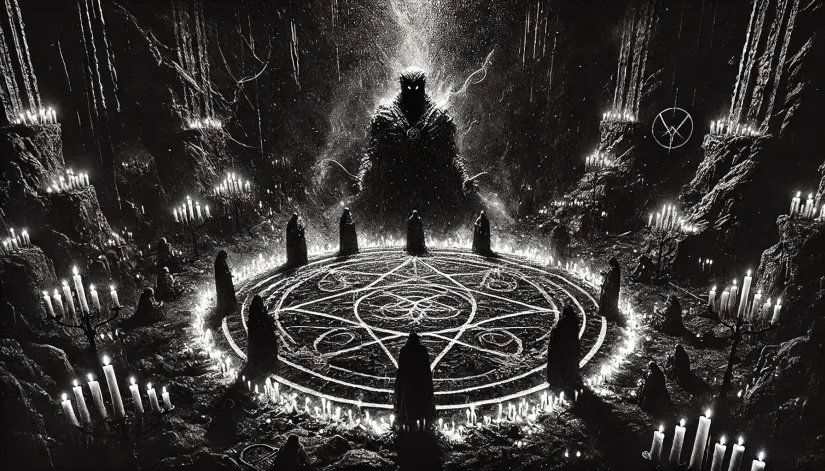Paimon, the Great King of Hell, is one of the most influential demons in the hierarchy of Hell.
You might’ve heard his name from the infamous “Ars Goetia”—he’s one of the 72 rulers of Hell listed there. In these old texts, he’s typically depicted as a powerful entity of immense respect and authority. And yeah, unlike other demons, Paimon is often depicted as an educator. A guide even.
He may offer truth and understanding to those who summon him—though you should know: it comes at a cost.
Paimon’s loyalty to Lucifer, his ability to influence both the physical and metaphysical realms and his unique depiction as a regal, musical entity set him apart from his peers. He commands many legions of lesser demons, and he’s often accompanied by two loyal kings—Lebal (or Bebal) and Abalam.
In this article:

Origins and Background
Let’s start by taking a closer look at Paimon’s origins. Where does this demon come from?
Well, as with all demons, it all starts with his Fall from Heaven. However, he wasn’t always a Great King of Hell. Nope—he was an angel, belonging either to the Order of Dominions or Cherubim, though accounts differ.
He was among the high angels most captivated by Lucifer’s music. You see, the Morning Star’s melodies were powerful, almost hypnotic. And Paimon was one of the angels who tried to match the notes on his own instruments, drawn to the beauty of Lucifer’s talents.
Even though he was impressed, Lucifer let his pride get in the way. He didn’t pay much attention to Paimon’s dedication. Yet, the angel remained loyal. Unsurprisingly, when Lucifer’s rebellion against Heaven began, Paimon was right there at his side.
During the War in Heaven, Paimon fought alongside Lucifer but was defeated by the angel Haziel. And, like the other rebel angels, he was cast down to Hell.
There, he attended Lucifer’s rally at Pandemonium—the seat of Hell’s government—and declared himself Lucifer’s most loyal servant. His dedication didn’t go unnoticed.
Thanks to his loyalty and usefulness, Paimon was elected as one of the Nine Kings of Hell and joined Hell’s musical choir, which sings praises to Lucifer.
That’s one of the origin stories.
According to other myths, the demon’s musical and regal traits might even have roots in earlier mythologies. Some occult scholars believe that Paimon may have “emerged” from older deities, like the Mesopotamian god Ea or Enki—gods linked to wisdom and music.
Even the name “Paimon” likely has roots in ancient languages. Some scholars suggest that the name could be derived from “Pa’amon,” a Hebrew word that means “bell,” which could symbolize his connection to music and harmony.
| Attribute | Details |
|---|---|
| Aliases | Paimon, Paymon, Paimonia |
| Titles | Great King of Hell |
| Race | Demon |
| Pantheon | Goetic Demonology (possibly linked to Middle Eastern mythology, such as Ea or Enki) |
| Personifies | Knowledge, arts, sciences, secret wisdom, music, royal authority |
| Appearance | Crowned man riding a dromedary camel, accompanied by musicians playing trumpets and cymbals |
| Abilities | Profound knowledge of arts and sciences, command over spirits, visions, influence over elements, supernatural power |
| Equipment | Crown, scepter (often symbolic in representations) |
| Associated Elements | Air, water |
| Gem/Crystal | Not explicitly mentioned, but connections to regal symbolism hint at gold or other precious metals |
| Associated Figures | Lucifer, other Kings of Hell, Lebal (Bebal), Abalam |
| Astrological Influence | Not explicitly stated, but likely linked to celestial and astrological concepts due to royal status |
| Summoning Requirements | Sigil, offerings like frankincense, candles, music, and incantations for ceremonial invocation |
| Affiliations | Commands 25 to 200 legions of spirits, depending on the source; among Nine Kings of Hell |
| Alignment | Chaotic, depending on ritual context and intent |
| Historical Mentions | Ars Goetia, Livre des Esperitz, Pseudomonarchia Daemonum, Liber Officiorum Spirituum |

Titles and Rank
Despite the source, it’s pretty evident that Paimon isn’t just any demon. He’s a Great King of Hell, as described in the “Ars Goetia,” where he’s listed as one of the most powerful demons.
Besides Paimon, the other eight Kings of Hell are:
Together, these kings shape much of the governance within the hierarchy of Hell, ruling over all the Kingdoms of Hell.
In terms of military power, Paimon commands anywhere from 66 to 200 legions of demons, although some sources, like the “Livre des Esperitz,” say it’s more like 25 legions.

What Does Paimon Look Like?
So, what does Paimon actually look like? He’s typically depicted as a crowned man riding a dromedary camel. The crown and scepter emphasize his royal status, and the camel? Well, that symbolizes endurance—something you need if you’re a king ruling both the spiritual and material realms.
The demon doesn’t ride alone, though. He’s often accompanied by an entourage of musicians, playing trumpets, cymbals, and other instruments. This music is a callback to his time in Heaven (where he was captivated by Lucifer’s melodies). It may also suggest his continued love for harmony, even in Hell.
Nevertheless, Paimon’s depictions can vary quite a bit. Sometimes, he looks almost human—imposing, regal. Other times, artists give him more otherworldly features, with exaggerated facial expressions or even a luminescent aura that signifies his power. But the camel is a constant. That camel emphasizes his mix of majesty and mysticism.
Paimon’s Powers and Abilities
The demon King’s abilities stretch far beyond just knowledge and power. He’s a master not only of arts and sciences but also of the mind, able to create visions, influence thoughts, and even reveal secrets that many would prefer to remain hidden.
His dominion includes manipulating spirits, commanding elements like water and air, and bringing forth hidden truths. With supernatural power transcending the physical and metaphysical realms, Paimon’s influence touches almost every aspect of existence—seen and unseen.
Knowledge of Arts and Sciences
Paimon’s got a whole list of abilities, but the biggest one is his deep knowledge. He knows all arts and sciences, and that’s a major reason why magicians seek him out.
The “Ars Goetia,” Johann Weyer’s “Pseudomonarchia Daemonum,” the “Livre des Esperitz,” and the “Liber Officiorum Spirituum” all describe Paimon as a high-ranking demon of profound wisdom.
The “Goetia” and Weyer emphasize that he knows all arts and “secret Things”—like the secrets of the Earth, its waters, and its winds. According to “Livre des Esperitz” and the “Liber Officiorum Spirituum,” the demon can answer any question truthfully, making him a major source of information.
This is very much unlike what other demons do. Constantly twisting the truth. Always sharing half-truths.
Bestowing Dignities and Lordships
Paimon has the power to grant titles and elevate individuals. Most sources hint toward these powers. And it’s not surprising, given his status as a king—he can bestow dignities, lordships, and even influence over others.

Commanding Spirits and Familiars
Paimon can summon and control spirits on behalf of his summoner. Both the “Goetia” and Weyer credit him with the ability to grant familiars—loyal spirits who assist and teach their masters.
But let me be clear, these aren’t your average animal companions; these are familiars offered by a demon, and there are significant downsides to keep in mind.
Familiars have a long, dark history tied to witchcraft in Europe. During the infamous witch trials—especially those from the 15th to the 17th centuries—familiars were often cited as proof of a witch’s pact with the devil.
Many believed these spirits (which could take on animal or even human-like forms) were granted by demons like Paimon to serve witches. The witch trials across Europe—from England to Germany—frequently featured accusations involving familiars.
Simply put, anyone found with a supposed familiar—like a pet cat, toad, or bird—could be accused of witchcraft, tortured, and even executed.
During the European werewolf trials of the late 16th century, familiars were also linked to the transformation of individuals into werewolves.
Familiars were known to drain the energy of their masters, sometimes requiring offerings in return—blood, life force, or even loyalty bound to the demon.
Interestingly, the “Liber Officiorum Spirituum” uniquely mentions that Paimon has command over fish, adding a curious aspect to his dominion. While this might seem benign, in historical contexts, controlling animals—particularly aquatic creatures—was seen as an extension of dominion over the natural world.
Supernatural Abilities
Paimon’s supernatural abilities go even further. According to “The Book of Abramelin,” Paimon can reanimate the dead, create visions, and summon objects (or people).
He can also fly, remain underwater indefinitely, and perform extraordinary feats of power. He can “make all kinds of things” and “all sorts of people and armor appear” at the magician’s request.
There’s even a mention in “Sloane MS 3824” about an experiment involving Paimon to make a thief return stolen items. Clearly, Paimon’s power extends across many domains.
Seal of Paimon
The seal of Paimon is a powerful symbol first mentioned in grimoires like “The Lesser Key of Solomon.” However, rather than being a literal tool for summoning, the sigil is symbolic—it represents Paimon’s authority, his dominion, and the bridge between the physical and spiritual realms.
Demons have seals because they are beings of immense power, and their influence must be symbolically controlled or directed.
Unlike angels (who do not have individual seals because their power is viewed as inherently aligned with a higher purpose, free from personal ambition or chaos), demons require these symbols to delineate their roles, powers, and the boundaries of their influence.
Paimon in Modern Media and Pop Culture
If you’re unfamiliar with demonic literature, you’ve probably seen or heard of Paimon from the horror movie “Hereditary” (2018). The film brought the demon into mainstream attention, depicting him as a sinister entity.
In the movie, his influence drives some pretty dark and unsettling events. Now, the film doesn’t stick closely to traditional demonological texts, but it sure captures his mystique.
Paimon also pops up in occult-themed media, from video games to novels and TV shows. For example, in “Dungeons & Dragons,” he’s portrayed as an enigmatic figure with vast knowledge.







